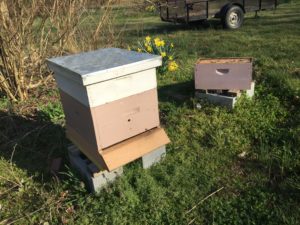 The first hive inspections of the year are always an adventure of up’s and down’s, although “inspection” is a strong word for it. Typically, I am going to 3 or 4 yards, checking hive weight (lifting the back of hive) and pulling off each super and/or brood chamber until I get to the bottom box and then I level her out for the year. Finally, I remove the entrance reducer if one was placed on her last Fall.
The first hive inspections of the year are always an adventure of up’s and down’s, although “inspection” is a strong word for it. Typically, I am going to 3 or 4 yards, checking hive weight (lifting the back of hive) and pulling off each super and/or brood chamber until I get to the bottom box and then I level her out for the year. Finally, I remove the entrance reducer if one was placed on her last Fall.
As long as there are lots of bees, decent hive weight and they are bringing in pollen that is about all that I do. I make a quick note about weight and how many bees are in the hive. The heaviest (with the most honey) are noted as emergency stores for any light hive and ones with the most bees are noted for early Nucs. The majority are simply noted for when I believe it will be good to check again and (maybe) drop a honey super or two on them. In rare situations (lots of bees, but low honey), I will make a note to quickly bring a super (or at least a few frames) of honey from another hive out to them.
Now, to the challenges! Sometimes, I find only a few bees. As will be noted from my past “lesson’s learned”, I do not like to spend a lot of time on a queen that is a poor performer. Even so, I will give her the benefit of the doubt (in these early inspections) and make a note to drop a few frames of capped brood in the hive (from a strong hive.) Maybe two or three at the most. I already know that a hive with this few bees is unlikely to produce honey this year, but I am willing to take a chance that her genetics are good, she just drew a poor hand this past Winter. But, that’s it. The hive needs to show marked improvement in about 40 days, otherwise I will be re-queening them.
Finally, the dreaded Dead-out’s. I know they are out there, the very first time I don the beekeeping suit for the year. The question is “how many”. I have been fortunate to only lose between 5 and 10% of my hives in any Winter, but I know the Big One is in my future. Will it be this year? My first outing this year was to my westernmost yard which literally looks out over the city of Richmond on its eastern side. That yard had two mature hives and one overwintered Nuc. For the first time in my recollection, I arrived at a yard to find all hives were deadouts. The nuc, in fact, had died the previous Fall (based on the wax moth damage). The other two were pristine, with a good bit of honey and pollen, but no bees. I could not help but wonder if this would be my experience with the rest of my hives. I did very little “Winter Prep” last Fall, due to work related issues consuming all of my time. Would I lose a ton of my hives?
As fate would have it, the next three yards that I visited had very strong hives and even one overwintered Nuc that was only in ONE NUC body (I run overwintered Nucs in 2 Nuc bodies, so this one slipped thru the cracks because of how busy I was last Fall.) That little queen had made it through the Winter on 5 frickin’ frames!!! Booyah! I did have a couple of other deadouts in other yards, but the rest of the hives were roaring strong. And so the year begins, with successes and failures. I like to think that the strongest continue to thrive and my genetic pool gets stronger and stronger with each passing year.
